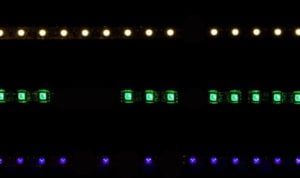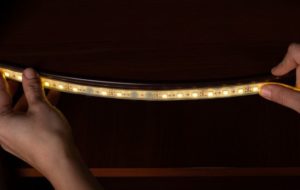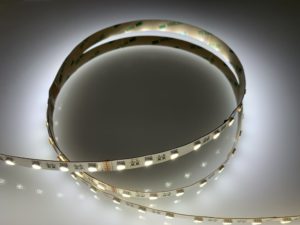Reconnecting Loose Connections
Loose connections are a common culprit when it comes to flickering LED strip lights. This issue arises when the current flow is interrupted, resulting in inconsistent lighting or even dead zones. To address this, first, identify the loose connection. This might be evident where the LED strip light isn’t lighting properly or is flickering.
In the case of solderless connectors, the remedy could be as simple as unplugging the strip from the connector and reinserting it. Ensure the strip is well-seated and secure. For soldered connections, you may need to re-solder the joints. Make sure the solder joint is shiny and smooth, which indicates a good connection.
Remember, proper safety measures, including wearing protective gear and working in a well-ventilated space, are important when soldering.
Replacing Faulty Sections
Faulty LED chips can cause dead zones or sections of your LED strip light not to light up. In such cases, you’ll need to replace the defective section of the strip. Start by identifying the faulty section – this would be the part that doesn’t light up when power is applied.
Once identified, cut out the faulty section with a pair of sharp scissors, ensuring you cut along the designated cut lines to avoid damaging the remaining strip. Next, replace the removed part with a new, functional strip section. Using connectors compatible with your strip type, link the new piece with the rest of the strip. Ensure all connections are secure and the entire strip lights up evenly when powered.
Choosing the Right Power Supply
An underpowered or faulty power supply can lead to flickering LED strip lights or dead sections. The LED Driver must be capable of delivering the required current and voltage for your specific LED strip.
If the power supply is the issue, upgrading to one with a higher capacity might solve the problem. Verify the voltage and current requirements of your LED strip, typically provided in the product specifications, and select a power supply that meets these needs. Notably, using an overrated power supply is better than an underrated one, as the strip will only draw the power it needs.
Check out our LED Driver Calculator
Preventing Voltage Drop
Voltage drop, especially relevant for longer LED strips, leads to the far end of the strip being dim or not lighting up at all. It occurs due to the resistance of the wire, causing a decrease in voltage as the current moves along the strip.
To mitigate voltage drops, consider a higher voltage LED strip. Higher voltage strips reduce current flow and subsequently, the voltage drop. Another approach involves using a thicker wire, which decreases resistance and improves current flow. Alternatively, injecting power at multiple points along the strip, rather than just at one end, ensures a consistent voltage along its length.
Preventive Measures
To avoid these issues in the future, a few preventive measures can be highly beneficial. Proper installation is the first step – follow the manufacturer’s instructions closely to ensure correct setup. Regular maintenance, such as cleaning the strip and checking for loose connections, helps in the early identification of potential issues.
Lastly, opting for high-quality products makes a significant difference. High-quality LED strips and power supplies, like those available at LED Lighthouse, come with superior build quality and fewer defects, providing better performance, and experiencing fewer issues over their lifespan.



